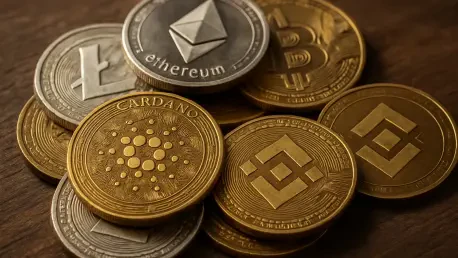Setting the Stage for a Financial Revolution
Imagine a world where traditional financial assets, once confined to rigid, slow-moving systems, are seamlessly transformed into digital tokens, accessible to investors across the globe with just a few clicks. This is no longer a distant vision but a reality taking shape within the decentralized finance (DeFi) ecosystem. Sei Network, a high-performance Layer 1 blockchain, stands at the forefront of this transformation through its innovative approach to asset tokenization. With institutional giants like BlackRock and Brevan Howard entering the space, the stakes have never been higher. This review dives deep into the technology powering Sei Network’s tokenization capabilities, exploring how it bridges the gap between traditional finance (TradFi) and DeFi, and evaluates its potential to redefine capital markets.
Understanding the Backbone of Sei Network
Sei Network emerges as a specialized blockchain designed to address the inefficiencies of traditional financial systems. As a Layer 1 solution, it prioritizes speed and cost-effectiveness, blending the robust security of Ethereum with the rapid transaction processing reminiscent of Solana. This unique architecture positions Sei as a prime candidate for handling the complex demands of tokenized real-world assets (RWAs), which require both reliability and efficiency to ensure seamless integration into broader financial ecosystems.
Tokenization, the process of converting physical or financial assets into digital tokens on a blockchain, lies at the heart of Sei’s mission. By enabling fractional ownership and enhancing liquidity, this technology unlocks access to high-value investments that were previously out of reach for many. Sei’s infrastructure supports this by providing a scalable environment where tokenized assets can be traded, managed, and integrated into DeFi applications, paving the way for a more inclusive financial landscape.
The significance of Sei’s role cannot be overstated, especially in its ambition to merge TradFi with DeFi. Institutional adoption of blockchain technology hinges on platforms that can deliver not only performance but also trust and compliance. Sei Network aims to fulfill this need, positioning itself as a critical player in reshaping how capital markets operate by fostering an environment where digital and traditional investments coexist harmoniously.
Core Features Driving Sei’s Tokenization Technology
High-Performance Blockchain Infrastructure
At the core of Sei Network’s appeal is its meticulously engineered blockchain infrastructure, optimized for high-speed transactions at minimal cost. Unlike many other networks that struggle with congestion during peak usage, Sei’s design ensures that tokenized assets can be processed with remarkable efficiency. This capability is vital for supporting on-chain trading experiences that outpace the sluggish processes often associated with traditional financial systems.
The technical prowess of Sei lies in its ability to handle large volumes of transactions without compromising on security. By integrating elements of Ethereum’s proven framework with innovations focused on throughput, the network offers a robust platform for institutions looking to tokenize assets. This balance of speed and safety makes it an attractive choice for financial entities seeking to explore blockchain solutions without exposing themselves to undue risk.
Beyond raw performance, Sei’s user-centric design enhances its suitability for tokenization. The network minimizes latency and reduces transaction fees, ensuring that end-users, whether institutional or individual, can interact with tokenized assets in a cost-effective manner. This focus on accessibility underscores Sei’s potential to become a cornerstone of digital asset management in the coming years.
KAIO’s Institutional-Grade Tokenization Protocol
Complementing Sei’s infrastructure is KAIO, a protocol dedicated to the tokenization of real-world assets, which has already facilitated the digitization of over $200 million in assets from industry titans such as BlackRock and Brevan Howard. KAIO’s integration with Sei Network creates a powerful synergy, enabling the creation of secure, programmable, and compliant financial products tailored for a crypto-native audience.
KAIO’s strength lies in its ability to transform complex financial instruments into digital tokens that retain their value and regulatory integrity. This process ensures that tokenized shares, such as those of the BlackRock ICS US Dollar Liquidity Fund, can be seamlessly incorporated into DeFi ecosystems while adhering to strict compliance standards. The result is a product that appeals to institutional investors seeking both innovation and stability.
Moreover, KAIO’s framework supports advanced functionalities like real-time programmability, allowing tokenized assets to be used as collateral or yield-bearing reserves within DeFi applications. This adaptability, bolstered by Sei’s high-performance network, positions KAIO as a leader in bridging the gap between conventional investment vehicles and the dynamic world of decentralized finance.
Recent Milestones in Sei’s Tokenization Journey
The tokenization landscape on Sei Network has witnessed significant advancements with the launch of tokenized shares from prominent funds like the BlackRock ICS US Dollar Liquidity Fund and the Brevan Howard Master Fund. These developments mark a pivotal moment, showcasing the network’s capacity to handle institutional-grade assets and cater to a growing demand for low-volatility, yield-bearing digital investments.
Emerging trends point to a surge in institutional interest in blockchain-based solutions that offer both security and scalability. Sei, in collaboration with KAIO, has responded to this shift by developing innovative tools that streamline the tokenization process. Their combined efforts ensure that digital assets can be integrated into existing financial systems, providing a smooth transition for institutions hesitant to fully embrace DeFi.
These milestones also highlight Sei’s strategic vision to serve as an institutional settlement layer for digital assets. By processing billions of transactions across millions of wallets, the network demonstrates its readiness to support the infrastructure demands of modern capital markets. This progress signals a maturing ecosystem poised for even greater adoption in the near term.
Real-World Impact of Sei’s Tokenization Capabilities
Sei Network’s tokenization technology is already making tangible impacts by democratizing access to alternative investment products. Institutional and accredited investors can now engage with tokenized funds that were once confined to exclusive circles, thanks to Sei’s ability to facilitate secure and efficient transactions on-chain.
A standout application is the use of tokenized assets within DeFi protocols as collateral or reserves that generate yield. For instance, funds tokenized on Sei can be leveraged in lending platforms or stablecoin architectures, creating new revenue streams and enhancing liquidity. This versatility showcases how Sei’s technology extends beyond mere digitization to enable novel financial strategies.
Additionally, the integration of these tokenized products into broader capital markets illustrates Sei’s role in modernizing investment frameworks. By providing a platform where traditional assets can interact with decentralized systems, Sei fosters an environment of innovation, allowing financial institutions to explore uncharted territories in asset management and investor engagement.
Challenges Facing Sei’s Tokenization Efforts
Despite its impressive strides, Sei Network faces several hurdles in its tokenization endeavors, particularly around regulatory complexities. Navigating the intricate web of global financial regulations remains a significant challenge, as tokenized assets must comply with diverse legal standards to gain widespread acceptance among institutional players.
Technical scalability also presents a concern, especially as the volume of tokenized assets grows. While Sei’s infrastructure is designed for high performance, the influx of massive institutional transactions could strain the network if not addressed proactively. Continuous enhancements to capacity and throughput will be essential to maintain its competitive edge.
Market adoption barriers further complicate the landscape, as traditional financial entities may hesitate to embrace blockchain due to unfamiliarity or perceived risks. Sei, alongside KAIO, is actively working to mitigate these issues through compliance-focused frameworks and educational initiatives, aiming to build trust and foster greater acceptance among cautious stakeholders.
Future Outlook for Sei’s Tokenization Technology
Looking ahead, Sei Network holds immense promise in shaping the future of tokenization with potential breakthroughs in programmable financial infrastructure. The ability to create smart contracts and automated processes for tokenized assets could revolutionize how investments are managed, offering unprecedented levels of efficiency and customization.
The ambition to establish Sei as the institutional settlement layer for digital assets remains a guiding vision. If successful, this could position the network as a central hub for all tokenized transactions, streamlining interactions between TradFi and DeFi while enhancing transparency and reducing operational costs across the board.
Over the long term, Sei’s impact on capital markets could be transformative, particularly in terms of investor accessibility. By lowering barriers to entry and enabling fractional ownership of high-value assets, the technology has the potential to democratize wealth creation, reshaping the financial ecosystem for generations to come.
Reflecting on Sei’s Tokenization Achievements
Looking back, Sei Network’s journey in tokenization has proven to be a groundbreaking chapter in the convergence of traditional and decentralized finance. Its high-performance infrastructure, coupled with KAIO’s institutional-grade protocol, has delivered a robust platform that successfully brought major funds like those from BlackRock and Brevan Howard into the digital realm. Moving forward, the focus should shift toward addressing regulatory and scalability challenges through strategic partnerships and technological upgrades. Stakeholders must also prioritize education to accelerate market adoption, ensuring that institutions fully grasp the benefits of tokenized assets. As the landscape evolves, Sei’s commitment to innovation and compliance will be crucial in solidifying its position as a leader in redefining capital markets for a digital age.









